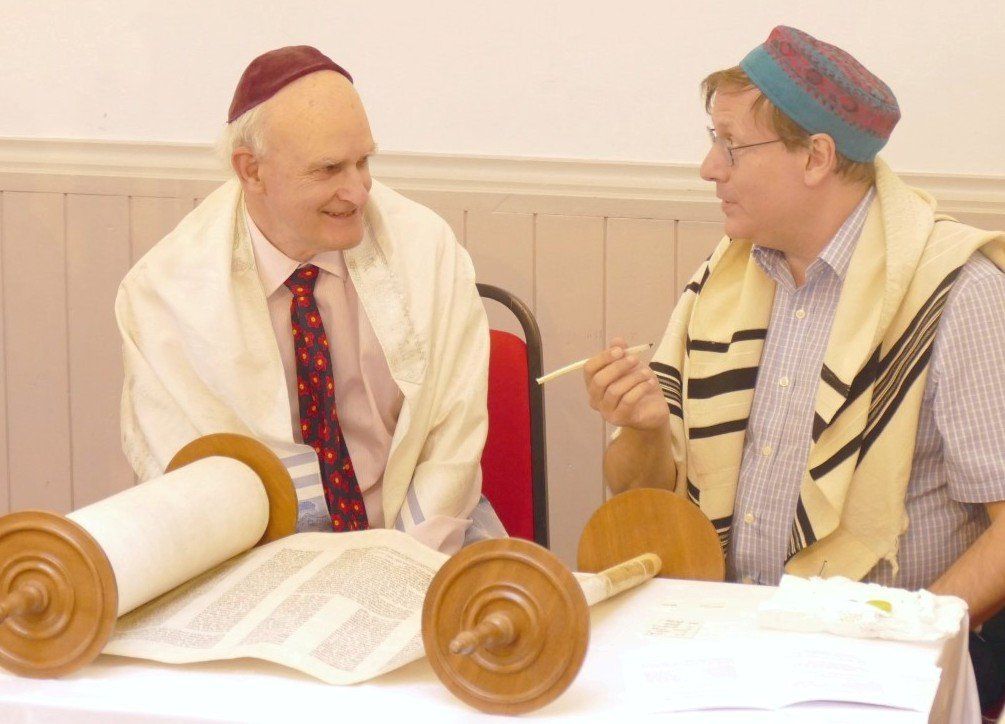
The siyyum
- Torah
completion ceremony
When a Torah
is finished it marks a great accomplishment and mitsvah
and will be marked by communal festivities known as a siyyum hatorah
(completion of the torah). Various customs have developed over the years and indeed new customs will spring up all the time. The customs below are culled in part from the Sefer Chinnuch Sefer Torah
as found in the book, the 613th commandment with a few modern interpolations. I also maintain a custom that my teacher Vivian z"l
also kept, that when a Torah
has undergone significant restoration and has been away for some considerable time, I hold a renewal siyyum
to introduce it back into the community.
Suggested approach to a siyyum
At the entrance to the synagogue a person holding one, three (symbolising kadosh kadosh kadosh
(holy holy holy [is the Lord of Hosts) or kohanim, levi'im
and yisraelim, or torah, avodah
(service) and gemilut chassidim
(good deeds)) or indeed all of the Sifrey Torah
greet the new Torah
and lead it towards the ark.
If not all the Sifrey Torah
are out the remainder are removed from the ark.The shema
is chanted. All the Sifrey Torah
encircle the bimah
(platform) and the new Sefer Torah
is then opened and laid on a flat surface for completion. Traditionally the 18 last letters are completed (symbolising the word chai
- life). 18 people could therefore be called for the honour each completing a letter. These people are usually either major donors towards the cost of the scroll and/or people that the congregation wish to honour because of special service. However any number of letters may be written (more or less) so that anyone who wants to participate can. When I am doing a siyyum
for a Torah
that has undergone extensive restoration as opposed to a new one, I usually leave some 10 letters that require repair.
There are various ways of completing the letters. If the person feels confident and have practiced and are shomer
then they may be able to write the letter themselves, however this is not usual. More often the person will hold the arm of the scribe as he completes the letter on their behalf acting as their agent. Some scribes will draw the outline of the letters and then people may fill in the outline or have the scribe fill it in whilst they hold his arm. The very last letter may be completed by the rabbi or the major donor.
Before 'writing' each person must say: Hareyni ani kotev (kotevet) leshem k’dushat Sefer Torah
(behold I am writing for the sake of the holiness of the Sefer Torah). There are no specific b'rachot
for the writing or completion of a scroll as the mitsvah
is similar to those of sukkah
and shofar. One does not say a blessing when one has made a sukkah, but rather when one has dwelt in it. One does not say a blessing having made a shofar
out of a rams horn, rather only when blows it. The mitsvah
is bound up with the use of a Torah
(for which there are specific blessings) not merely its writing.
A nice touch is for each letter to be written with a newly cut quill and for those who received the honour to receive the quill along with a t'udah
(certificate) commemorating the occasion.
As each letter is written the scribe sounds it out (as is the case with all letters). One very nice minhag
(custom) I saw for the first time recently had children parading round the synagogue with 18 giant letters as each letter was called out one child rose with their golden letter and walked round.
One of those responsible for the checking of the Torah
(it should have been read through by three rabbis) might then wish to declare publicly that the scroll is now fit for public use.
On completion of the reading all should chant chazak chazak v’nitchazek
(be strong be strong and we will be strengthened). The donor or rabbi then recites the shehecheyanu
blessing which thanks God for keeping us alive to see this event. The prayer y'did nefesh
is sung. A special prayer then can be made for the donors or contributors to the mitsvah
and their families.
A sermon, d'var torah
or programme takes place followed by a seudat mitsvah, a special meal marking the occasion. Most importantly the celebrations should be joyous as if we were receiving torah from Mount Sinai. My article A Taste of Sinai
(available for free on Academia
but also part of the Festschrift for my father Rabbi Maurice Michaels) gives more details around the importance of the mitsvah
of writing a Sefer Torah
and how participating in this mitsvah
at a siyyum
can be compared to receiving it from Sinai.

Above: Just getting ready to write with one of the people honoured at a siyyum in Sheffield. Unfortunately I'm not sure who took the photo but will find out for a credit.
